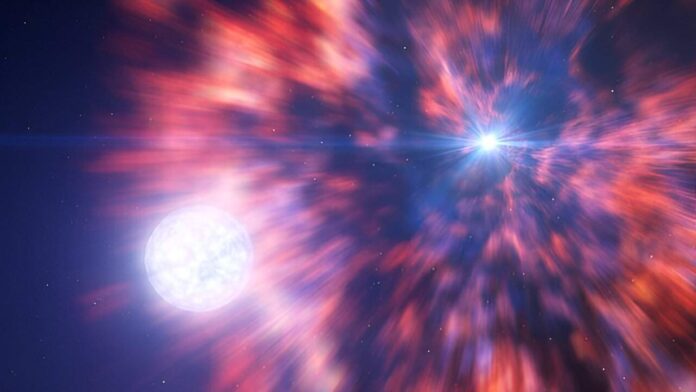Astronomers have found a direct link between the explosive deaths of massive stars and the formation of the most compact and enigmatic objects in the universe—black holes and neutron stars. With the help of the European Southern Observatory’s Very Large Telescope (ESO’s VLT) and ESO’s New Technology Telescope (NTT), two teams were able to observe the aftermath of a supernova explosion in a nearby galaxy, finding evidence for the mysterious compact object it left behind.
When massive stars reach the end of their lives, they collapse under their own gravity so rapidly that a violent explosion known as a supernova ensues. Astronomers believe that, after all the excitement of the explosion, what is left is the ultra-dense core, or compact remnant, of the star. Depending on how massive the star is, the compact remnant will be either a neutron star—an object so dense that a teaspoon of its material would weigh around a trillion kilograms here on Earth—or a black hole—an object from which nothing, not even light, can escape.
Astronomers have found many clues hinting at this chain of events in the past, such as finding a neutron star within the Crab Nebula, the gas cloud left behind when a star exploded nearly a thousand years ago. But they had never before seen this process happen in real-time, meaning that direct evidence of a supernova leaving behind a compact remnant has remained elusive.
“In our work, we establish such a direct link,” says Ping Chen, a researcher at the Weizmann Institute of Science, Israel, and lead author of a study published Jan. 10 in Nature and presented at the 243rd American Astronomical Society meeting in New Orleans, U.S.
The researchers’ lucky break came in May 2022, when South African amateur astronomer Berto Monard discovered the supernova SN 2022jli in the spiral arm of the nearby galaxy NGC 157, located 75 million light-years away. Two separate teams turned their attention to the aftermath of this explosion and found it to have a unique behavior.
After the explosion, the brightness of most supernovae simply fades away with time; astronomers see a smooth, gradual decline in the explosion’s “light curve.” But SN 2022jli’s behavior is very peculiar: As the overall brightness declines, it doesn’t do so smoothly, but instead oscillates up and down every 12 days or so.
“In SN 2022jli’s data we see a repeating sequence of brightening and fading,” says Thomas Moore, a doctoral student at Queen’s University Belfast, Northern Ireland, who led a study of the supernova published late last year in The Astrophysical Journal. “This is the first time that repeated periodic oscillations, over many cycles, have been detected in a supernova light curve,” Moore noted in his paper.
Both the Moore and Chen teams believe that the presence of more than one star in the SN 2022jli system could explain this behavior. In fact, it’s not unusual for massive stars to be in orbit with a companion star in what is known as a binary system, and the star that caused SN 2022jli was no exception. What is remarkable about this system, however, is that the companion star appears to have survived the violent death of its partner and the two objects, the compact remnant and the companion, likely kept orbiting each other.
The data collected by the Moore team, which included observations with ESO’s NTT in Chile’s Atacama Desert, did not allow them to pin down exactly how the interaction between the two objects caused the highs and lows in the light curve. But the Chen team had additional observations. They found the same regular fluctuations in the system’s visible brightness that the Moore team had detected, and they also spotted periodic movements of hydrogen gas and bursts of gamma rays in the system. Their observations were made possible thanks to a fleet of instruments on the ground and in space, including X-shooter on ESO’s VLT, also located in Chile.
Putting all the clues together, the two teams generally agree that when the companion star interacted with the material thrown out during the supernova explosion, its hydrogen-rich atmosphere became puffier than usual. Then, as the compact object left behind after the explosion zipped through the companion’s atmosphere on its orbit, it would steal hydrogen gas, forming a hot disk of matter around itself. This periodic stealing of matter, or accretion, released lots of energy that was picked up as regular changes of brightness in the observations.
Even though the teams could not observe light coming from the compact object itself, they concluded that this energetic stealing can only be due to an unseen neutron star, or possibly a black hole, attracting matter from the companion star’s puffy atmosphere. “Our research is like solving a puzzle by gathering all possible evidence,” Chen says. “All these pieces lining up lead to the truth.”
With the presence of a black hole or neutron star confirmed, there is still plenty to unravel about this enigmatic system, including the exact nature of the compact object or what end could await this binary system. Next-generation telescopes such as ESO’s Extremely Large Telescope, scheduled to begin operation later this decade, will help with this, allowing astronomers to reveal unprecedented details of this unique system.
References:
Ping Chen et al, A 12.4-day periodicity in a close binary system after a supernova, Nature (2024). DOI: 10.1038/s41586-023-06787-x
T. Moore et al, SN 2022jli: A Type Ic Supernova with Periodic Modulation of Its Light Curve and an Unusually Long Rise, The Astrophysical Journal Letters (2023). DOI: 10.3847/2041-8213/acfc25
